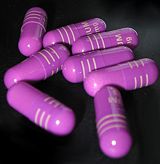From Proteopedia
proteopedia linkproteopedia link
The Pharmaceutical industry is one of the world’s largest industries, grossing well over $300 billion in the United States alone. Understanding how the drugs the pharma industry develops work and different characteristics of these compounds is important to nearly everyone as 50% of the US population takes at least one prescription medication regularly and nearly everyone takes a pharmaceutical pill at some point in their life.[1] See also WHO Model Lists of Essential Medicines. The following is a growing list of pharmaceutical compounds organized by disorder.
See Pharmaceutical Drug Targets for a list of drug targets organized by disease.
The majority of all modern medicinal drugs target members of the superfamily of proteins called the G protein-coupled receptors or GPCRs[2][3].
Treatments
The following is a list of pharmaceutical treatments for various diseases, organized by disorder. Each entry highlights general information about the therapeutic, pharmacokinetic data comparisons within its drug class, and a structural analysis explaining how the drug compound functions in vivo.
|
|
|
|
Antagonists at glutamatergic NMDA receptors
|
|
|
|
See Treatment of multiple myeloma
Anti-prostate cancer
Anti-myeloma
Anti-acute lymphocytic leukemia
Anti-non-small cell lung cacinoma
B-Raf Kinase Inhibitor
- Zelboraf - Generic: Vemurafenib (Formerly: PLX-4032)
Chemotherapy
Estrogen Receptor Modulator
mTOR inhibitor
- Rapamune - Generic: Sirolimus (Rapamycin)
- Afinitor - Generic: Everolimus
- Torisel - Generic: Temsirolimus
Multiple Receptor Tyrosine kinase (VEGFR, PDGFR, EGFR, KIT, Abl, RAF kinase) Inhibitors
See Treatment of chronic myelogenous leukemia, Treatment of hepatocellular carcinoma, Treatment of renal cell carcinoma, Treatment of gastrointestinal stromal tumor, VEGFR inhibitors and Tyrosine-kinase inhibitors.
Poly ADP ribose polymerase (PARP) inhibitors
See also Anti-cancer drugs, Anticancer drugs and RAF kinase inhibitors
|
|
Depression
|
|
Erectile Dysfunction
|
Tricyclic Antidepressants
Selective Serotonin Reuptake Inhibitors
Serotonin–norepinephrine reuptake inhibitor
Serotonin–dopamine reuptake inhibitor
See Atypical antipsychotics
|
|
Mechanism is not completely understood
Inhibitors of the sodium glucose co-transporter-2 (SGLT-2)
|
|
Phosphodiesterase Type 5 Inhibitor
- Cialis - Generic: Tadalafil
- Levitra - Generic: Vardenafil
- Viagra - Generic: Sildenafil
|
|
|
|
|
|
Niemann-Pick C1-like 1 (NPC1L1) protein blocker
|
|
Inhibitors of neprilysin
Renin inhibitors
Angiotensin II receptor antagonist
|
|
Chemokine Receptor Type 5 (CCR5) Inhibitors
- Selzentry - Generic: Maraviroc
- Baraclude - Generic: Entecavir
- Emtriva - Generic: Emtricitabine
- Epivir - Generic: Lamivudine
- Hivid - Generic: Zalcitabine
- Retrovir - Generic: Zidovudine
- Videx - Generic: Didanosine
- Viread - Generic: Tenofovir
- Zerit - Generic: Stavudine
- Ziagen - Generic: Abacavir
Cytochrome P450 inhibitors
Combinations
|
|
|
|
|
|
- Voltaren - Generic: Diclofenac also may inhibit phospholipase A2 as part of its mechanism of action.
|
|
|
- MScontin, Oramorph, Sevredol - Generic: Morphine (opioid receptor agonist)
- Demerol - Generic: Meperidine (opioid receptor agonist)
- Dolophine - Generic: Methadone (Levomethadone (the R enantiomer) is a opioid receptor agonist)
- Actiq, Duragesic, Fentora - Generic: Fentanyl (opioid receptor agonist)
- Narcan - Generic: Naloxone (competitive opioid receptor antagonist)
- ReVia - Generic: Naltrexone (competitive opioid receptor antagonist)
- Entereg - Generic: Alvimopan (opioid receptor antagonist)
|
|
Viral diseases
|
Asthma
|
Various diseases
|
Anti-viral RNA synthesis
Anti-chickenpox and cytomegalovirus infection and herpes and shingles
|
|
|
Anti-swelling
Voltage-gated sodium (Nav) channel inhibitors
Anti-epilepsy
Voltage-gated sodium (Nav) channel inhibitors
Anti-psoriasis
Anti-glaucoma and mountain sickness
Anti-gastroesophageal reflux disese
H/K transporting ATPase inhibitor
Local anesthetic
|
|
References
- ↑ http://www.npr.org/blogs/health/2010/09/03/129626052/a-portrait-of-health-prescription-drugs-in-america
- ↑ Overington JP, Al-Lazikani B, Hopkins AL. How many drug targets are there? Nat Rev Drug Discov. 2006 Dec;5(12):993-6. PMID:17139284 doi:10.1038/nrd2199
- ↑ Peeters MC, van Westen GJ, Li Q, IJzerman AP. Importance of the extracellular loops in G protein-coupled receptors for ligand recognition and receptor activation. Trends Pharmacol Sci. 2011 Jan;32(1):35-42. PMID:21075459 doi:10.1016/j.tips.2010.10.001

